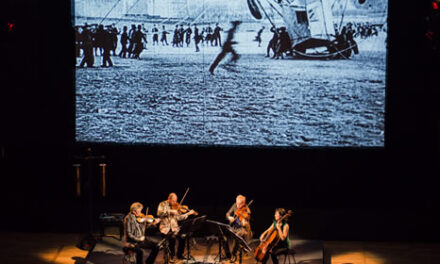The Raleigh Chamber Music Guild and the North Carolina Museum of Art founded the innovative Sights and Sounds series a decade ago. Its goals were to spotlight North Carolina-based groups in unique programs often complementing the Museum of Art’s exhibitions. Concerts are informal with projections of art from the collections and commentary by some of the performers. The ensemble that played on the first concert was Aurora Musicalis and, except for the keyboard player, the same original musicians were on stage for this concert. Connecticut-based pianist Kari Miller began playing with the eclectic group in 1998. All the other players are long-time members of the North Carolina Symphony: Concertmaster Brian Reagin, Assistant Concertmaster Rebekah Binford, Associate Principal Cellist Elizabeth Beilman, and Principal Clarinetist Jimmy Gilmore.
The irrepressible Gilmore provided light-hearted commentary about the music and the classical style art works projected. Darkening the entire stage considerably enhanced the clarity of these images over past efforts during concerts I have reviewed. In honor of her many unheralded efforts on behalf of chamber music; Aurora Musicalis dedicated this entire concert to Nancy Lambert. Executive Director of the Guild.
The ensemble played the Trio Sonata for two violins and continuo in C, HMV.403, “Saul” of George Frideric Handel (1685-1759) which was featured on the very first concert of the series. Like Bach and other 18th century composers, Handel shamelessly raided and reworked his own pieces. Gilmore alluded to the composer’s use of this trio sonata in his oratorio Saul. In his Handel, Christopher Hogwood specifies its use as the basis for the overture of the oratorio. The trio sonata is in a typical four movement work with alternating fast and slow tempos. Balances between violinists Reagin and Binford and the continuo, harpsichordist Miller and cellist Beilman were excellent. The string intonation was secure, and the tone was warm. The violinists exhibited refined skill and taste in carefully graduated dynamics and in matching phrasing and sound. The two middle movements gave Beilman’s cello more scope to shine.
The Concerto a Tre for clarinet, violin, and cello (1947) by Ingolf Dahl (1912-70) is exactly the little-known treasure an unconventional combination of instruments such as Aurora Musicalis brings to the public’s attention. Its three parts are played seamlessly without pause. Gilmore said Dahl’s main influence in this work is the neo-classicism of Igor Stravinsky, but the slower middle episode suggests the spacious sound of Aaron Copland. Dahl gives all three players a thorough workout using a full gamut of techniques, high, glassy harmonics, a plethora of pizzicato-types, rapid clarinet runs, and a myriad of instrumental timbres, all set in every imaginable combination for three players. The elegiac, lyrical middle portion was immediately winning and a flowing, long cello melody set against an agitated, fast violin was memorable.
Franz Schubert (1797-1828) wrote two great piano trios in quick succession but the first in B-flat, D.898, is played nearly four times as frequently as the second. It was all the more welcome that Aurora Musicalis chose to perform the Trio No. 2 in E-flat, D.929, for piano, violin, and cello. According to Melvin Berger, in Guide to Chamber Music, my favorite crutch, “some commentators criticize (it) for being overly long and for having less-than-inspired melodies.” None of this was remotely sensed in the course of a deeply involving, white-hot performance by pianist Miller, violinist Reagin, and cellist Beilman. String versus keyboard balance was extraordinarily good and Miller’s superb articulation of the piano part was never less than breath-taking. The give and take between players was delightful and their choices of phrasing and tempos made one want the trio to last longer. About the wonderful cello melody that opens the second movement, Berger reports “According to Leopold Sonnleithner, one of Schubert’s friends, the main theme … is a Swedish song that the composer heard sung by Issak Albert Berg, a tenor from Sweden who visited Vienna in 1827.” Beilman spun this glorious tune in a seamless line with a full, rich tone. This was a superb performance of the trio by any measure.











